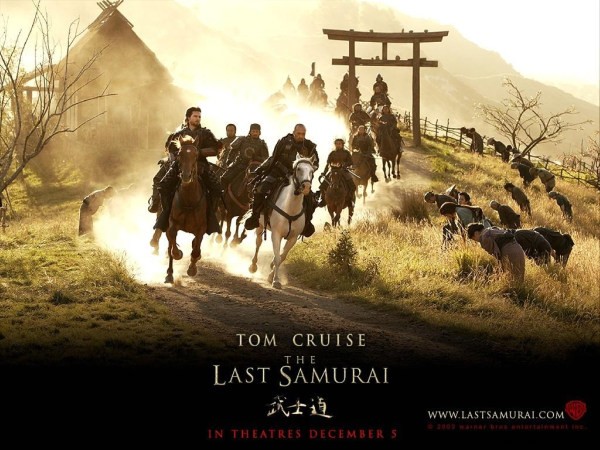This is the true story on which the movie «The Last Samurai is inspired. » (2003), starring Tom Cruise and directed by Edward Zwick. Tom Cruise plays Nathan Algren , a US Army soldier who arrives in Japan during the Meiji Restoration, a transitional period that ended the Tokugawa Shogunate . The clans, feudal lords (daimyos ), samurai and shoguns ruled Japan for years, but were displaced and relegated by modernity and industry in the West. The figure of the Emperor existed at that time of the Shogunate, although it was relegated to a discreet background. It would be, then, from the Meiji Restoration to the end of the Second World War, when the Emperor would take center stage.

Although Japan had apparently been isolated from the world for a long time, this isolation (Sakoku ) was never complete. Contact with Europeans, such as the Portuguese and Spanish, had already occurred years before through missionaries and traders ("namban » or «barbarians from the south » was the name that the Japanese gave to the Spanish and Portuguese). Other events that occurred in Asia, such as the Japanese invasion of Korea and its end at the hands of Admiral Yi Sun Sin with their turtle ships in Noryang or years before the two Mongol invasions of Kublai Khan in which Japan was saved thanks to storms and strong winds (hence the word kamikaze or «divine wind «), show that Japan was not so isolated and that it was on the maps. It would be Commodore Perry which would have a relevant role in the opening of Japan to the West with the signing of the Treaty of Kanagawa in 1854. Nathan, in fact, is inspired by a historical character who lived at that time, but he was not an American but the French Jules Brunet .

Jules Brunet
Brunet was born in Belfort, in the East of France, in 1838. In 1857 he graduated from the École Polytechnique in Paris, specializing in artillery. Between 1862-1867 he participated in the second French intervention in Mexico under the orders of Napoleon III, where Brunet stood out for his bravery receiving the Légion d’Honneur . It would be in 1867 when Brunet would arrive in Yokohama as a member of the first French military mission in Japan. His task as a member of said mission was to train and instruct the elite forces of Shogun Tokugawa Yoshinobu . During this mission, Brunet was fascinated by Japanese traditions and culture, but as also happens in the film, it was a period of political instability. In 1868 the Meiji Emperor he officially seized power, power that the Shogun had held for 600 years. The Emperor was endorsed and supported by many clans, but the Shogun did not recognize the Emperor... and a civil war (Boshin started ) that pitted the open faction, led by the Emperor, against the Shogun and the supporters of tradition.
Imperial troops marched to Edo , where the French ambassador Léon Roches drew up a plan to defend the city, but at the last moment the Shogun decided to set it aside and his troops were defeated on March 29, 1868 at the Battle of Koshu-Katsunama . Two months later, Edo capitulated and Yoshinobu surrendered. A few of the Shogun's men, including Brunet and four French officers, managed to escape with the help of Admiral Enomoto Takeaki. , loyal to the Tokugawa Shogunate, to Ezo Island north of Japan (modern Hokkaidō ). On September 3, 1868, Edo was renamed Tokyo and the Meiji Emperor established himself in what, from then on, will be the capital of Japan. Napoleon III declared the neutrality of France. However, Brunet and the officers decided to abandon the mission of the French army and join Takeaki in the hope of regrouping the troops and being able to fight back. With Jules Brunet in command, the rebels besieged and captured the fort of Goryokaku , in the hands of the imperial troops. Other victories would follow until conquering Hakodate , where on December 15, 1868 the Republic of Ezo was proclaimed , appointing Enomoto Takeaki as president. France and other European nations reacted by recognizing the Republic of Ezo (the only one in Japanese history).

Proclamation of the Republic
In March 1869, about 10,000 men from the Imperial Army arrived at Ezo, where Brunet, the four French officers (Fortant , Marlin , Cazeneuve and Bouffier ) and some 3,000 men of the Republic stage an epic resistance. Finally, the numerical superiority overcame the enthusiasm of the supporters of the Shogunate and they were defeated in May 1869. When the Goryokaku fort fell, there was only a garrison of 800 men from the Republic of Ezo against 8,000 from the Imperial army... It was the end of 600 years of the Shogunate and the Japanese adventure of Jules Brunet . He left Japan for France, where despite being greeted as a hero, he was tried for disobeying orders to stay out. Still, he was able to continue his military career by reaching the rank of general.
Despite what Brunet did, Franco-Japanese collaboration continued in the Meiji Restoration:two other missions arrived in Japan in 1872 and 1884 with the aim of modernizing the Japanese army. Two French officers were the first Westerners to be accepted into a prestigious dojo and practice Japanese martial arts. In 1886, the engineer Louis Emile-Bertin he was entrusted with the construction of the first modern Japanese Navy, becoming a close friend of the Emperor. In 1919, French engineers oversaw the creation of Japan's first aviation force.
Today, Jules Brunet's name has almost been forgotten in France, but the Japanese still remember the French soldier who fought alongside the last samurai.
Collaboration of Pedro Sanmartín
Sources and images:A Brief History of Japan – Mikiso Hane, Boshin War
